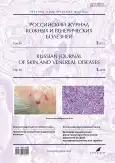Clinical and immunological evaluation of secukinumab efficacy in patients with hidradenitis suppurativa
- Authors: Udzhukhu V.Y.1,2, Gumennaia E.R.1, Shemshuk M.I.1, Kubylinskiy A.A.1
-
Affiliations:
- The Russian National Research Medical University named after N.I. Pirogov
- Peoples' Friendship University of Russia
- Issue: Vol 28, No 3 (2025)
- Pages: 259-266
- Section: DERMATOLOGY
- URL: https://bakhtiniada.ru/1560-9588/article/view/313073
- DOI: https://doi.org/10.17816/dv677840
- EDN: https://elibrary.ru/PCOQZP
- ID: 313073
Cite item
Abstract
BACKGROUND: Hidradenitis suppurativa is a relatively rare chronic dermatosis with a severe and treatment-resistant course that significantly impairs patients’ quality of life and poses a serious medical and social issue.
AIM: To evaluate the clinical and immunological efficacy of secukinumab in patients with hidradenitis suppurativa.
METHODS: The study included 12 patients (7 men and 5 women) aged 12 to 52 years with hidradenitis suppurativa. A control group comprised 20 conditionally healthy volunteers. The severity and dynamics of clinical symptoms during treatment were assessed using the Hidradenitis Suppurativa Severity Index. T helper cells (Th) were analyzed using CD3 and CD4 antibodies. Th cell differentiation was assessed with CD45RA and CD62L markers. Serum interleukin levels were measured via enzyme immunoassay. All 12 patients with hidradenitis suppurativa received secukinumab for 16 weeks.
RESULTS: Positive changes in the clinical course of hidradenitis suppurativa were observed within one week of initiating secukinumab gene-engineered therapy, with continued regression of efflorescences leading to significant clinical improvement by the end of the 16-week treatment course. Treatment resulted in normalization of peripheral blood levels of Th17 and Treg cells, as well as Th17/Treg and IL-17A/IL-10 ratios.
CONCLUSION: A pronounced Th17/Treg imbalance may serve as a marker of disease severity in hidradenitis suppurativa and a rationale for initiating biologic therapy with secukinumab.
Full Text
##article.viewOnOriginalSite##About the authors
Vladislav Yu. Udzhukhu
The Russian National Research Medical University named after N.I. Pirogov; Peoples' Friendship University of Russia
Email: sovet140011@mail.ru
ORCID iD: 0000-0002-3351-9138
SPIN-code: 2066-2303
MD, Dr. Sci. (Medicine), Professor
Russian Federation, Moscow; MoscowElvira R. Gumennaia
The Russian National Research Medical University named after N.I. Pirogov
Email: elvgumenny@mail.ru
ORCID iD: 0000-0002-8097-2816
MD
Russian Federation, MoscowMarina I. Shemshuk
The Russian National Research Medical University named after N.I. Pirogov
Author for correspondence.
Email: mshemshuk@mail.ru
ORCID iD: 0000-0002-7984-4454
SPIN-code: 9806-4362
MD, Cand. Sci. (Medicine), Associate Professor
Russian Federation, MoscowAleksandr A. Kubylinskiy
The Russian National Research Medical University named after N.I. Pirogov
Email: cubsalex@mail.ru
ORCID iD: 0000-0002-4645-8215
SPIN-code: 2911-5496
MD, Cand. Sci. (Medicine), Associate Professor
Russian Federation, MoscowReferences
- Burova SA, Potekaev NN, Borodulina KS. Hidradenitis suppurativa: Prevalence, etiopathogenesis, comorbidity (part 1). Russian journal of Clinical dermatology and venereology. 2019;18(2):111–114. doi: 10.17116/klinderma201918021111 EDN: NLHCPI
- Potekaev NN, Burova SA, Borodulina KS. Epidemiological and socio-hygienic features of purulent hydradenitis. Russian journal of Clinical dermatology and venereology. 2020;19(1):13–17. doi: 10.17116/klinderma20201901113 EDN: EBRJMV
- Saunte DM, Jemec GB. Hidradenitis suppurativa: Advances in diagnosis and treatment. JAMA. 2017;318(20):2019–2032. doi: 10.1001/jama.2017.16691
- Burova SA, Borodulina KS. Hydradenitis suppurativa: Issues of pathogenesis, rating scales, treatment. Overview (part 2). Russian journal of Clinical dermatology and venereology. 2019;18(3):265–269. doi: 10.17116/klinderma201918031265 EDN: PDRMJV
- Olisova OY, Sokolovskiy EV, Khairutdinov VR, et al. Hidradenitis suppurativa: Definition, epidemiology, etiology, diagnosis (part 1). Вестник дерматологии и венерологии. 2024;100(2):18–30. doi: 10.25208/vdv14876 EDN: RKVLDI
- Goldburg SR, Strober BE, Payette MJ. Hidradenitis suppurativa: Epidemiology, clinical presentation, and pathogenesis. J Am Acad Dermatol. 2020;82(5):1045–1058. doi: 10.1016/j.jaad.2019.08.090
- Lowe MM, Naik HB, Clancy S, et al. Immunopathogenesis of hidradenitis suppurativa and response to anti-TNF-alphatherapy. JCI Insigh. 2020;5(19):e139932. doi: 10.1172/jci.insight.139932
- Liu T, Li S, Ying S, et al. The IL-23/IL-17 pathway in inflammatory skin diseases: From bench to bedside. Front Immunol. 2020;11:594735. doi: 10.3389/fimmu.2020.594735
- Sachen KL, Greving CN, Towne JE. Role of IL-36 cytokines in psoriasis and other inflammatory skin conditions. Cytokine. 2022;156:155897. doi: 10.1016/j.cyto.2022.155897
- Zouboulis CC, Frew JW, Giamarellos-Bourboulis EJ, et al. Target molecules for future hidradenitis suppurativa treatment. Exp Dermatol. 2021;30(1):8–17. doi: 10.1111/exd.14338
- Gudjonsson JE, Tsoi LC, Ma F, et al. Contribution of plasma cells and B cells to hidradenitis suppurativa pathogenesis. JCI Insight. 2020;5(19):e139930. doi: 10.1172/jci.insight.1399
- Wolk K, Join-Lambert O, Sabat R. Aetiology and pathogenesis of hidradenitis suppurativa. Br J Dermatol. 2020;183(6):999–1010. doi: 10.1111/bjd.19556
- Kurayev A, Ashkar H, Saraiya A, Gottlieb AB. Hidradenitis suppurativa: Review of the pathogenesis and treatment. J Drugs Dermatol. 2016;15(8):1017–1022.
- Chu CB, Yang CC, Tsai SJ. Hidradenitis suppurativa: Disease pathophysiology and sex hormones. Chin J Physiol. 2021;64(6):257–265. doi: 10.4103/cjp.cjp_67_21
- Gao JL, Otto TS, Porter ML, Kimball AB. Hidradenitis suppurativa: New targets and emerging treatments. Am J Clin Dermatol. 2024;25(5):765–778. doi: 10.1007/s40257-024-00880-1
- Tsai YC, Hung CY, Tsai TF. Efficacy and safety of biologics and small molecules for moderate-to-severe hidradenitis suppurativa: A systematic review and network meta-analysis. Pharmaceutics. 2023;15(5):1351. doi: 10.3390/pharmaceutics15051351
- Guermazi D, Shah A, Yumeen S, Saliba E. The use of biologics and JAK inhibitors in the management of moderate to severe hidradenitis suppurativa treatment: A scoping review. Arch Dermatol Res. 2024;316(6):259. doi: 10.1007/s00403-024-03121-x
- Martora F, Scalvenzi M, Ruggiero A, et al. Hidradenitis suppurativa and JAK inhibitors: A review of the published literature. Medicina (Kaunas). 2023;59(4):801. doi: 10.3390/medicina59040801
Supplementary files










